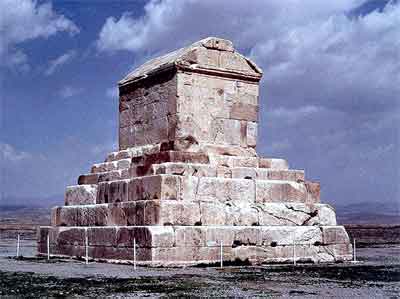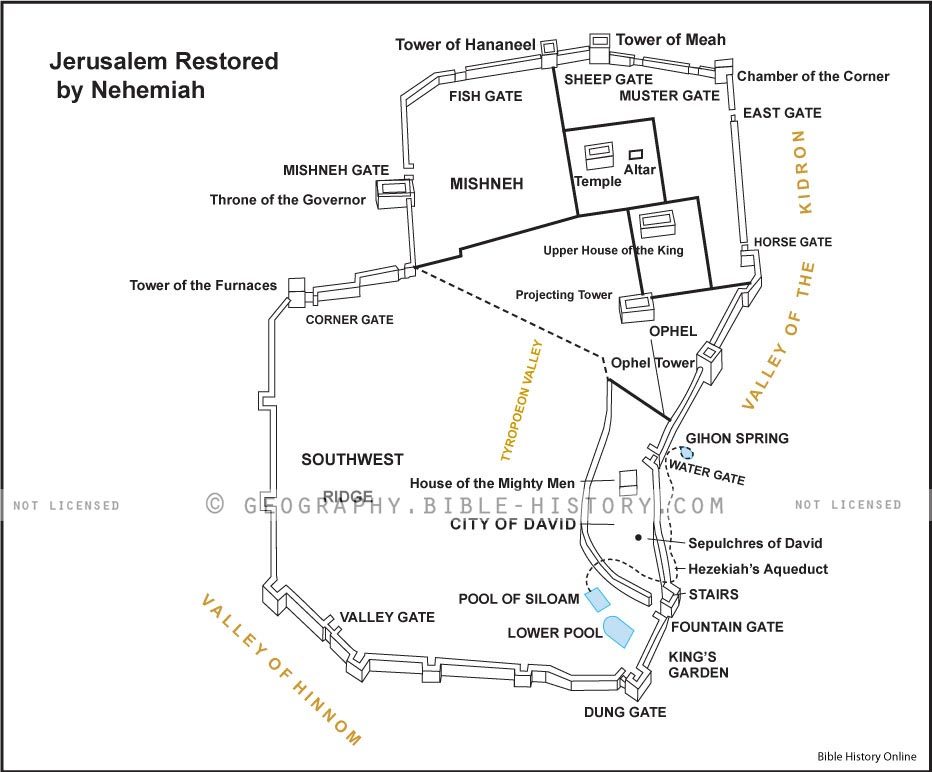The Book of Nehemiah
Nehemiah 1:7-9 - The words of Nehemiah the son of Hachaliah. And it came to pass in the month Chisleu, in the twentieth year, as I was in Shushan the palace, That Hanani, one of my brethren, came, he and [certain] men of Judah; and I asked them concerning the Jews that had escaped, which were left of the captivity, and concerning Jerusalem. And they said unto me, The remnant that are left of the captivity there in the province [are] in great affliction and reproach: the wall of Jerusalem also [is] broken down, and the gates thereof are burned with fire.
Nehemiah 13:1-3 - On that day they read in the book of Moses in the audience of the people; and therein was found written, that the Ammonite and the Moabite should not come into the congregation of God for ever; Because they met not the children of Israel with bread and with water, but hired Balaam against them, that he should curse them: howbeit our God turned the curse into a blessing. Now it came to pass, when they had heard the law, that they separated from Israel all the mixed multitude.
The Old Testament - A Brief Overview
Bible Survey - Nehemiah
Hebrew Name -
Nechemiyah
"Nehemiah"
Greek Name -
Neemias
(Greek form of the Hebrew)
Author - Nehemiah (Ezra and Nehemiah were treated as one book in Jewish Tradition)
Date - From 455-420 BC Approximately
Theme of Nehemiah - The rebuilding of Jerusalem
Types and Shadows - In Nehemiah Jesus is the one who led the captives out
Tomb of Cyrus the Great at Pasargadae

"O man, whoever you are and
wherever you come from, for I know that you will come--I
am Cyrus, son of Cambyses, who founded the Empire of the
Persians and was king of the East. Do not grudge me this
spot of earth which covers my body." - Cyrus
This tomb of the great Persian ruler, Cyrus, was discovered in 1951 at the ruins of Pasargadae (south-central Iran). Over 2500 years old, the tomb is in decent condition, made of white limestone and stands a total of 36 feet high. The tomb itself is 18 feet high resting on a 6 level base, also 18 feet high. It was built like a Ziggurat with Ionian and Lydian features. There is a small entrance and double doors leading to a room with no windows which once contained the "golden sarcophagus" of Cyrus, it is now an empty shell. Five huge stones make up its roof, which was slanted (gabled) to shed heavy rains. These Nordic gables were the architectural style of lands far to the north. The inscription was seen and recorded by Plutarch in AD 90.
Summary of The Book of Nehemiah
In Jewish tradition the books of Ezra and Nehemiah are regarded as one book, and it appears that they were originally two books because of the identical material in Ezra 2 and Nehemiah 7. Nehemiah made his journey to Jerusalem in about 445 BC, and he was not a priest or a scribe like Ezra was but he was a governor with authority given to him by the Persian king Artaxerxes to rebuild the walls and the city of Jerusalem for the Jewish people. He was originally cupbearer for the king of Persia (Nehemiah 2:1). Nehemiah completed the task in 52 days despite all the opposition from the foreigners who it settled in the land of Judah during the captivity.
The book of Nehemiah shows how God fulfilled his words written by the prophets concerning the return of the people of Israel from 70 years of captivity, and returned again to the land of their inheritance. In order to accomplish his divine will he change the hearts of the great kings of the ancient world, Cyrus Darius and Artaxerxes of Persia. He also worked through leaders like Joshua Zerubbabel Haggai Zechariah Ezra and Nehemiah in order to rebuild the wall of the city of Jerusalem and reestablish the law of Moses. The books of Ezra and Nehemiah reveal to us the history of the Jews between 536 BC and 430 BC. The book of Nehemiah covers the period from 445 BC for the next 12 years.
Quick Reference Map

Map of Jerusalem Restored by
Nehemiah (Click to Enlarge)
The contents of the two books may be analyzed as follows :
Outline of the Book of Nehemiah
1 ) Nehemiah's journey to Jerusalem, made possible by Artaxerxes, for the
purpose of re-building the wall (Nehemiah 1-2).
2 ) A list of the builders and the repairing of the gate (Nehemiah 3).
3 ) The rebuilding of the wall in spite of op-position led by Sanballat, Tobiah
and Geshem (Nehemiah 4:1-7:4).
4 ) The register of those who returned with Zerubbabel (Nehemiah 7).
5 ) The public reading and exposition of the book of the Law (Nehemiah 8).
6 ) The national repentance and the covenant of obedience (Nehemiah 9:1-10 :39).
7 ) Lists of inhabitants (Nehemiah 11:1-12:26).
8 ) Dedication of the wall and organization of the temple services (Nehemiah 12:27-47).
9 ) Nehemiah's reforms of abuses connected with tithes, the sabbath and mixed
marriages (Nehemiah 13).
In order to gain a complete picture of the history of this period, these two books should be examined also with the writings of the prophets Haggai, Zechariah and Malachi.
Quick Reference Maps - Nehemiah
Jerusalem Rebuilt by Nehemiah - The book of Nehemiah records in the third chapter a description of the course of the walls, beginning on the northeast side of Jerusalem and moving counterclockwise. His intention was not to be too exhaustive in the details.
Nehemiah Maps
Zerubbabel and Ezra's Journey to Restore Jerusalem - Zerubbabel, of the house of David heeded the decree of Cyrus to allow the Jews to return and restore Jerusalem and later more Jews including Ezra and Nehemiah returned to Jerusalem.
The Persian Empire in the 6th Century BC - The great rulers of the Persian Empire during the 6th century BC were Cyrus the Great, Cambyses, and Darius I the Great.
The Persian Empire in the 5th Century BC - During the 5th centuries BC the Persian Empire expanded under various rulers: Darius I, Xerxes I (Ahasuerus), and Artaxerxes I.
Nehemiah Resources
More About the Book of
Nehemiah
Nehemiah in the Picture
Study Bible
Timeline of the Ancient
World
Back to the Old Testament
Back to Bible
History Online